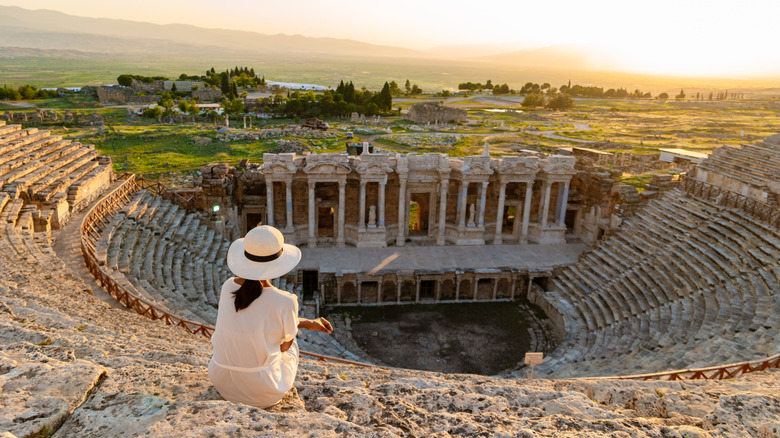Rick Steves Shares The Easiest Ways To Appreciate Europe's Ancient Sites Without Going Back To School
For decades, Rick Steves has taught travelers to explore Europe genuinely, advising against overhyped tourist traps and giving tips on how to experience the local culture and history genuinely. Yet, even the best-prepared traveler can find old stones a little underwhelming at first, especially when jet lag or hunger kicks in. Ancient sites might not seem thrilling at first glance. But as Steves points out on his website, "if you can imagine the ancient stones supporting ancient life, it's an unforgettable experience and a trip highlight."
To help ancient ruins feel a little less ... well, ruined, our expert recommends picking up a local souvenir book that shows you the "then" and "now" side by side. It's an easy way to spark your imagination and picture the space bustling with life. Most sites also rent audioguides, like the prehistoric city of Akrotiri in Santorini or the Altamira Cave in Spain; just punch in the number as you go and enjoy a surprisingly thorough narration. For those on a budget, there are often countless free audio guide options available online, depending on the site you plan to visit. If you crave context and connection, hiring a licensed guide can be the key. These professionals are trained to share the deeper meaning of the site, and Steves suggests that this is the best way to really "touch" Europe's history for yourself.
There's something grounding about standing in a spot where history happened. Even without a degree in archeology or history, you can feel the weight of what's been lost and what still lingers.
Smart Ways to Prepare for Ancient Site Sightseeing
For maximum appreciation, Steves recommends putting in a little groundwork, so the whole trip feels easier. Once your flight's booked, queue up a few films or documentaries set in your destination. Movies like "Gladiator" and "Pompeii" help you picture ancient Italy in its prime to gain context, long before today's quiet ruins. Then, once you've arrived, hit the local museum first — it's like getting to the plot twist before starting chapter one. These museums are often gold mines of local insight and small details that'll make the area feel richer and more authentic.
When the morning tour buses roll in, so do the crowds. Skip the madness between 10 a.m. and 4 p.m. unless you're ready to weave through selfie sticks. Instead, visit outside the peak hours for softer skies, fewer crowds, and more space to breathe. Sunrises and sunsets are the perfect setting for a thoughtful wander, especially at the Acropolis in Athens, as Steves says that evening is the best time to visit. Steves also notes that it's best to book your ticket online ahead of time and opt for a timed entry when possible.
Beyond the practical tips, there are some ethical considerations for preservation. The Archaeological Institute of America (AIA) suggests having a quick word with your guide before you explore, as most sites have specific dos and don'ts worth knowing. When in doubt, check the official website for guidelines and regulations, stay on marked trails, honor the space, be a gracious visitor, and respect the signs. There's an art to experiencing ancient sites, and it's not just about ticking off landmarks. In Steves' view, "there's plenty of information available for people who bring only a healthy dose of curiosity to the ancient sites." With the right mindset, even prehistoric ruins can feel alive.

